Ata Khalili
Member, IEEE
Resolving the Double Near-Far Problem via Wireless Powered Pinching-Antenna Networks
May 18, 2025Abstract:This letter introduces a novel wireless powered communication system, referred to as a wireless powered pinching-antenna network (WPPAN), utilizing a single waveguide with pinching antennas to address the double near-far problem inherent in wireless powered networks. In the proposed WPPAN, users harvest energy from spatially distributed pinching antennas in the downlink and use the collected power to transmit messages in the uplink. Furthermore, to manage the combinatorial complexity associated with activating the pinching antennas, we propose three approaches of varying complexity to simplify the original resource allocation problem and then solve it efficiently using convex optimization methods. Simulation results confirm that the proposed WPPAN system effectively mitigates the double near-far problem by providing antenna resources closer to the users, thereby enhancing both downlink energy harvesting and uplink data transmission.
Pinching Antenna-enabled ISAC Systems: Exploiting Look-Angle Dependence of RCS for Target Diversity
May 03, 2025Abstract:We investigate a novel integrated sensing and communication (ISAC) system supported by pinching antennas (PAs), which can be dynamically activated along a dielectric waveguide to collect spatially diverse observations. This capability allows different PAs to view the same target from different angles across time, thereby introducing target diversity, which is a key advantage over conventional fixed antenna arrays. To quantify the sensing reliability, we adopt the outage probability as a performance metric, capturing the likelihood that the accumulated radar echo signal power falls below a detection threshold. In contrast to traditional ISAC models that assume deterministic sensing channels, we explicitly account for the look-angle dependence of radar cross-section (RCS) by modeling it as a random variable. We ensure the long-term quality-of-service (QoS) for communication users by enforcing an accumulated data rate constraint over time. We derive an exact closed-form expression for the sensing outage probability based on the distribution of weighted sums of exponentially distributed random variables. Since the resulting expression is highly non-convex and intractable for optimization, we use a tractable upper bound based on the Chernoff inequality and formulate a PA activation optimization problem. A successive convex approximation (SCA) framework is proposed to efficiently solve the formulated problem. Numerical results show that dynamically activating different PAs across time slots significantly enhances sensing reliability compared to repeatedly activating the same PA at a fixed position and conventional antenna selection schemes, respectively. These findings highlight the benefits of integrating outage-based reliability metrics and target diversity into ISAC systems using PAs.
Movable Antenna Enabled ISAC: Tackling Slow Antenna Movement, Dynamic RCS, and Imperfect CSI via Two-timescale Optimizati
Mar 24, 2025Abstract:We investigate resource allocation for a movable antenna (MA) enabled integrated sensing and communication (ISAC) system scanning a sector for sensing and simultaneously serving multiple communication users using multiple variable-length snapshots. To tackle the critical challenges of slow antenna movement speed, dynamic radar cross section (RCS) variation, imperfect channel state information (CSI), and finite precision antenna positioning encountered in practice, we propose a novel two-timescale (TTS) optimization framework. In particular, we jointly optimize the discrete MA positions, the communication and sensing beamforming vectors, and the snapshot durations for minimization of the average transmit power at the base station (BS) while guaranteeing a minimum sensing and communication quality of service (QoS) and accounting for imperfect CSI. To overcome the slow antenna movement speed, the MA positions are adjusted only once per scanning period whereas the beamforming vectors and snapshot durations are adapted in every snapshot. Furthermore, to manage the impact of varying RCSs, a novel chance constraint for the sensing QoS is introduced. To solve the resulting challenging highly non-convex mixed integer non-linear program (MINLP), an efficient iterative algorithm exploiting alternative optimization (AO) is developed and shown to yield a high-quality suboptimal solution. Our simulation results reveal that the proposed MA enabled ISAC system cannot only significantly reduce the BS transmit power compared to systems relying on fixed-position antennas and antenna selection but also exhibits a remarkable robustness to RCS fluctuations and imperfect CSI. Furthermore, the proposed TTS framework achieves a similar performance as a system adjusting the MA positions in every snapshot, while the TTS approach significantly reduces the time used for MA adjustment.
Advanced ISAC Design: Movable Antennas and Accounting for Dynamic RCS
Jul 30, 2024


Abstract:We investigate resource allocation in integrated sensing and communication (ISAC) systems exploiting movable antennas (MAs) to enhance system performance. Unlike the existing ISAC literature, we account for dynamic radar cross-section (RCS) variations. Chance constraints are introduced and integrated into the sensing quality of service (QoS) framework to precisely control the impact of the resulting RCS uncertainties. Taking into account the dynamic nature of the RCS, we jointly optimize the MA positions and the communication and sensing beam design for minimization of the total transmit power at the base station (BS) while ensuring the individual communication and sensing task QoS requirements. To tackle the resulting non-convex mixed integer non-linear program (MINLP), we develop an iterative algorithm to obtain a high quality suboptimal solution. Our numerical results reveal that the proposed MA-enhanced ISAC system cannot only significantly reduce the BS transmit power compared to systems relying on fixed antenna positions and antenna selection but also demonstrates remarkable robustness to RCS fluctuations, underscoring the multifaceted benefits of exploiting MAs in ISAC systems.
Resource Allocation for UAV-Assisted Industrial IoT User with Finite Blocklength
Oct 24, 2023


Abstract:We consider a relay system empowered by an unmanned aerial vehicle (UAV) that facilitates downlink information delivery while adhering to finite blocklength requirements. The setup involves a remote controller transmitting information to both a UAV and an industrial Internet of Things (IIoT) or remote device, employing the non-orthogonal multiple access (NOMA) technique in the first phase. Subsequently, the UAV decodes and forwards this information to the remote device in the second phase. Our primary objective is to minimize the decoding error probability (DEP) at the remote device, which is influenced by the DEP at the UAV. To achieve this goal, we optimize the blocklength, transmission power, and location of the UAV. However, the underlying problem is highly non-convex and generally intractable to be solved directly. To overcome this challenge, we adopt an alternative optimization (AO) approach and decompose the original problem into three sub-problems. This approach leads to a sub-optimal solution, which effectively mitigates the non-convexity issue. In our simulations, we compare the performance of our proposed algorithm with baseline schemes. The results reveal that the proposed framework outperforms the baseline schemes, demonstrating its superiority in achieving lower DEP at the remote device. Furthermore, the simulation results illustrate the rapid convergence of our proposed algorithm, indicating its efficiency and effectiveness in solving the optimization problem.
On the Energy Efficiency of THz-NOMA enhanced UAV Cooperative Network with SWIPT
Sep 25, 2023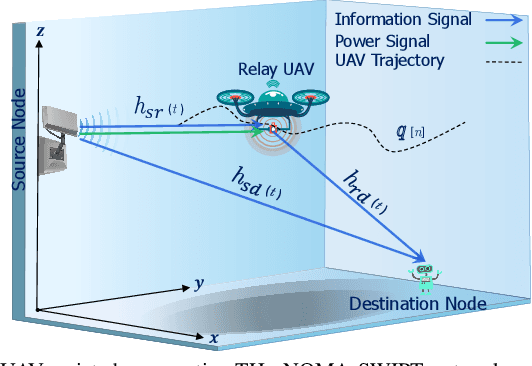
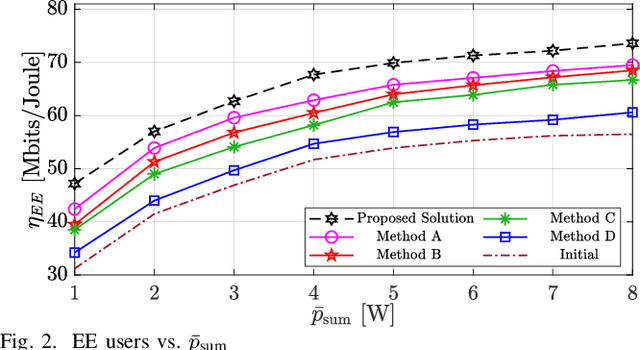
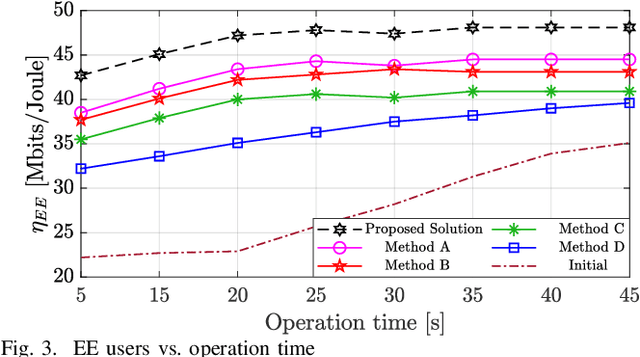
Abstract:This paper considers the energy efficiency (EE) maximization of a simultaneous wireless information and power transfer (SWIPT)-assisted unmanned aerial vehicles (UAV) cooperative network operating at TeraHertz (THz) frequencies. The source performs SWIPT enabling the UAV to receive both power and information while also transmitting the information to a designated destination node. Subsequently, the UAV utilizes the harvested energy to relay the data to the intended destination node effectively. Specifically, we maximize EE by optimizing the non-orthogonal multiple access (NOMA) power allocation coefficients, SWIPT power splitting (PS) ratio, and UAV trajectory. The main problem is broken down into a two-stage optimization problem and solved using an alternating optimization approach. In the first stage, optimization of the PS ratio and trajectory is performed by employing successive convex approximation using a lower bound on the exponential factor in the THz channel model. In the second phase, the NOMA power coefficients are optimized using a quadratic transform approach. Numerical results demonstrate the effectiveness of our proposed resource allocation algorithm compared to the baselines where there is no trajectory optimization or no NOMA power or PS optimization.
Energy-Aware Resource Allocation and Trajectory Design for UAV-Enabled ISAC
Feb 20, 2023



Abstract:In this paper, we investigate joint resource allocation and trajectory design for multi-user multi-target unmanned aerial vehicle (UAV)-enabled integrated sensing and communication (ISAC). To improve sensing accuracy, the UAV is forced to hover during sensing.~In particular, we jointly optimize the two-dimensional trajectory, velocity, downlink information and sensing beamformers, and sensing indicator to minimize the average power consumption of a fixed-altitude UAV, while considering the quality of service of the communication users and the sensing tasks. To tackle the resulting non-convex mixed integer non-linear program (MINLP), we exploit semidefinite relaxation, the big-M method, and successive convex approximation to develop an alternating optimization-based algorithm.~Our simulation results demonstrate the significant power savings enabled by the proposed scheme compared to two baseline schemes employing heuristic trajectories.
Smart Resource Allocation Model via Artificial Intelligence in Software Defined 6G Networks
Feb 09, 2023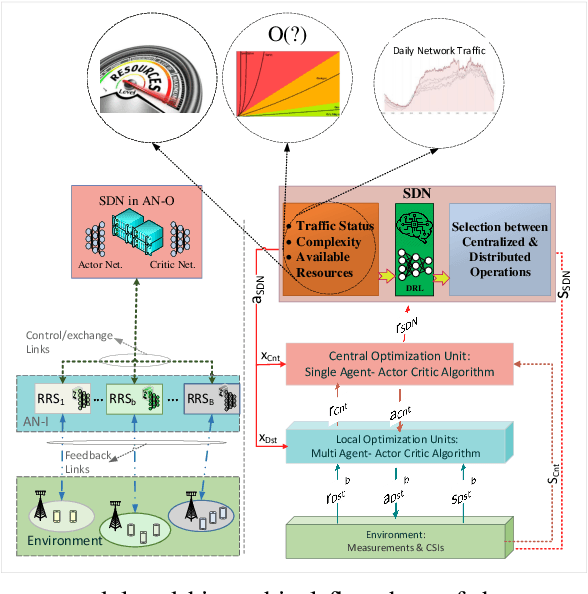

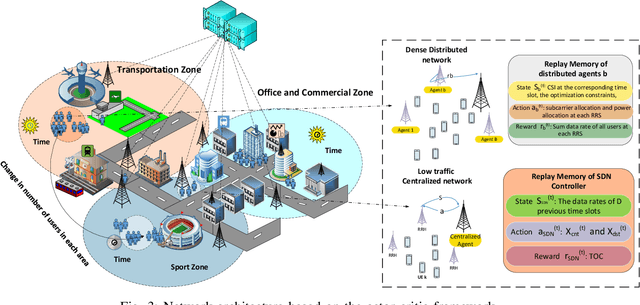
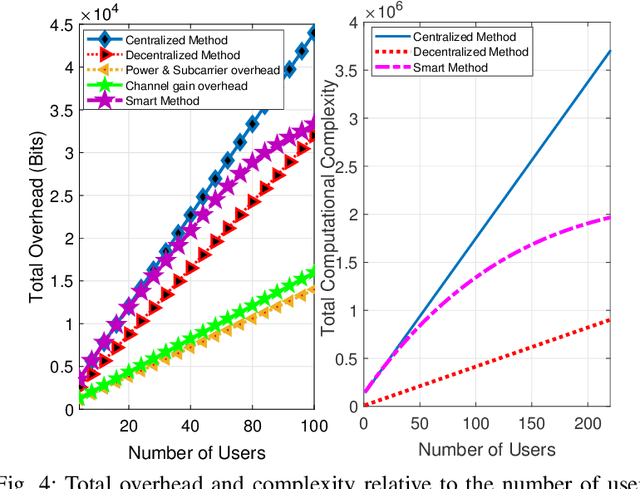
Abstract:In this paper, we design a new flexible smart software-defined radio access network (Soft-RAN) architecture with traffic awareness for sixth generation (6G) wireless networks. In particular, we consider a hierarchical resource allocation model for the proposed smart soft-RAN model where the software-defined network (SDN) controller is the first and foremost layer of the framework. This unit dynamically monitors the network to select a network operation type on the basis of distributed or centralized resource allocation procedures to intelligently perform decision-making. In this paper, our aim is to make the network more scalable and more flexible in terms of conflicting performance indicators such as achievable data rate, overhead, and complexity indicators. To this end, we introduce a new metric, i.e., throughput-overhead-complexity (TOC), for the proposed machine learning-based algorithm, which supports a trade-off between these performance indicators. In particular, the decision making based on TOC is solved via deep reinforcement learning (DRL) which determines an appropriate resource allocation policy. Furthermore, for the selected algorithm, we employ the soft actor-critic (SAC) method which is more accurate, scalable, and robust than other learning methods. Simulation results demonstrate that the proposed smart network achieves better performance in terms of TOC compared to fixed centralized or distributed resource management schemes that lack dynamism. Moreover, our proposed algorithm outperforms conventional learning methods employed in recent state-of-the-art network designs.
Integrated Sensing and Communication in Distributed Antenna Networks
Nov 02, 2022Abstract:In this paper, we investigate the resource allocation design for integrated sensing and communication (ISAC) in distributed antenna networks (DANs). In particular, coordinated by a central processor (CP), a set of remote radio heads (RRHs) provide communication services to multiple users and sense several target locations within an ISAC frame. To avoid the severe interference between the information transmission and the radar echo, we propose to divide the ISAC frame into a communication phase and a sensing phase. During the communication phase, the data signal is generated at the CP and then conveyed to the RRHs via fronthaul links. As for the sensing phase, based on pre-determined RRH-target pairings, each RRH senses a dedicated target location with a synthesized highly-directional beam and then transfers the samples of the received echo to the CP via its fronthaul link for further processing of the sensing information. Taking into account the limited fronthaul capacity and the quality-of-service requirements of both communication and sensing, we jointly optimize the durations of the two phases, the information beamforming, and the covariance matrix of the sensing signal for minimization of the total energy consumption over a given finite time horizon. To solve the formulated non-convex design problem, we develop a low-complexity alternating optimization algorithm which converges to a suboptimal solution. Simulation results show that the proposed scheme achieves significant energy savings compared to two baseline schemes. Moreover, our results reveal that for efficient ISAC in wireless networks, energy-focused short-duration pulses are favorable for sensing while low-power long-duration signals are preferable for communication.
Integrating Sensing, Computing, and Communication in 6G Wireless Networks: Design and Optimization
Jul 08, 2022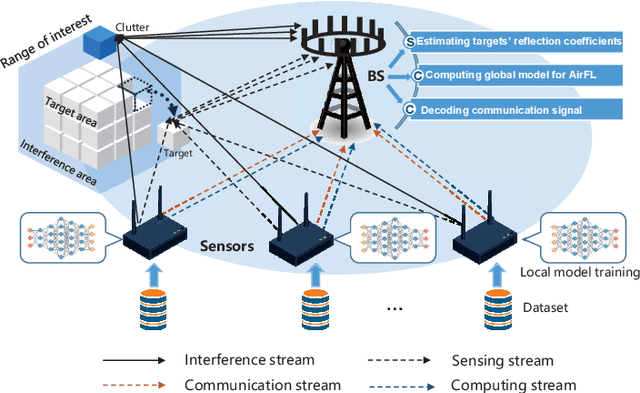
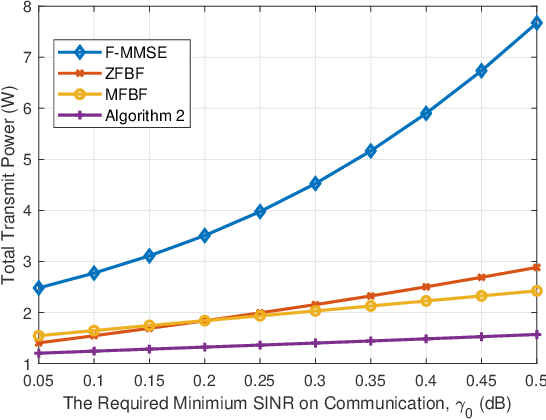
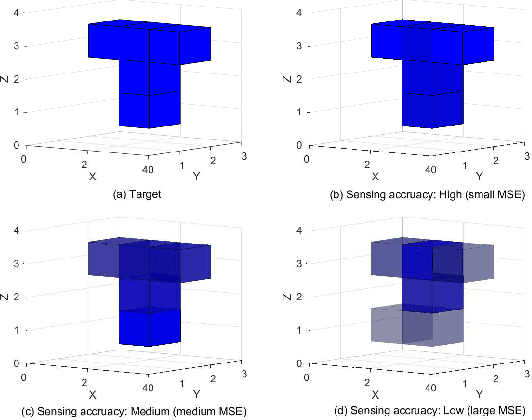
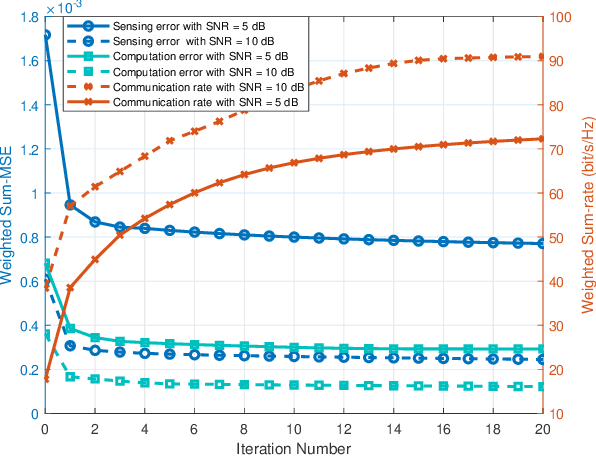
Abstract:The roll-out of various emerging wireless services has triggered the need for the sixth-generation (6G) wireless networks to provide functions of target sensing, intelligent computing and information communication over the same radio spectrum. In this paper, we provide a unified framework integrating sensing, computing, and communication to optimize limited system resource for 6G wireless networks. In particular, two typical joint beamforming design algorithms are derived based on multi-objective optimization problems (MOOP) with the goals of the weighted overall performance maximization and the total transmit power minimization, respectively. Extensive simulation results validate the effectiveness of the proposed algorithms. Moreover, the impacts of key system parameters are revealed to provide useful insights for the design of integrated sensing, computing, and communication (ISCC).
 Add to Chrome
Add to Chrome Add to Firefox
Add to Firefox Add to Edge
Add to Edge